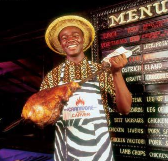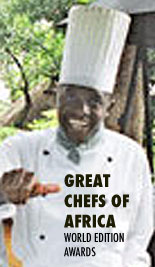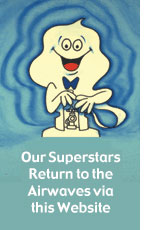|
|
 
|
|
|
|
|

http://www.gambiahomecooking.com
Carnivore Restaurant, Nairobi
 Since
1980 the Carnivore Restaurant in Nairobi has been an
important Kenya destination and an essential part of
any East Africa safari. Most food writers and
travelers will say "if you haven’t been to
Carnivore, you haven’t been to Kenya!” Since
1980 the Carnivore Restaurant in Nairobi has been an
important Kenya destination and an essential part of
any East Africa safari. Most food writers and
travelers will say "if you haven’t been to
Carnivore, you haven’t been to Kenya!”
The concept of
Carnivore reminds us of a Brazilian Churrascaria,
but with distinct African style. The Carnivore is a
meat specialty restaurant, twice voted amongst the
world’s 50 best restaurants by an expert panel in
‘Restaurant Magazine.”
We understand and do
not dispute that The Carnivore since its inception
has hosted over 2 million diners from across the
globe, including celebrities and VIPs of every
level.
The Carnivore is the ultimate 'Beast of a Feast' A
variety of meat including ostrich, crocodile and
camel, t is roasted over charcoal and carved at your
table. Delicious side dishes and an exceptional
array of sauces complement this fixed price feast
that also includes soup, a selection of desserts and
Kenyan coffee. Set in attractive tropical gardens,
the service and the décor are outstanding.
Whole joints of meat - legs of lamb and pork,
ostrich, rumps of beef, sirloins, racks of lamb,
spare ribs, sausages, chicken wings, skewered
kidneys, even crocodile, and other tasty morsels -
are roasted on traditional Maasai swords over a
huge, spectacular charcoal
pit that dominates the entrance of the restaurant.
Constantly basted and turned until cooked to
perfection, the meat is succulent and well flavoured.
The Carnivore doesn’t conform to the familiar
restaurant traditions of passing out menus and
waiting for people to order. Diners simply take
their seats on the Zebra
striped chairs and the movable feast begins. First
comes the soup of the day then a sizzling cast-iron
plate is placed in front of each guest along with a
plate of home baked brown bread and butter.
An army of carvers wearing zebra striped aprons and
straw hats then move from table to table carrying
the Masai swords laden with different prime meats
deliberately carving unlimited amounts onto the
sizzling, cast iron plates in front of each guest.
Accompanying
the meat feast is a wide selection of salads and
vegetable side dishes, and also a variety of exotic
sauces made from the Carnivore’s own recipes and
stacked on to a double storey-revolving tray in the
center of the table.
The atmosphere of The Carnivore combines the rustic
feel of a rural environment with the feeling of a
medieval banqueting hall. This was accomplished by
the use of streams and tropical gardens throughout
the restaurant, and by using rough-hewn beams and
local woods.
Another famous feature to set the tone of the
Carnivore experience is the house cocktail The 'Dawa'
( which means medicine or magic potion in Swahili).
This is based on a famous Brazilian drink, and was
introduced to Kenyans at The Carnivore. It has now
become one of the most widely consumed cocktails in
Kenya and it is brought to you on a portable tray by
the medicine man fittingly named Dr. Dawa.
THE KENYA TOURISM AWARDS 2012
Kenya Tourism Federation and Kenya Tourist Board
hosted the Kenya Tourism Awards 2012 at the
Carnivore
The Carnivore was privileged to win two awards:
Best Tourism Attraction
Best Entertainment Facility
The theme of the 2012 Awards was "Celebrate,
Sustain and Diversify Tourism"
LE QUARTIER FRANCAIS -
FRANSCHHOEK - SOUTH AFRICA
Nestled between towering mountains in the beautiful
Cape winelands, Franschhoek is an area that is world
renowned for its spectacular beauty, superb wines
and world-class restaurants.
Settled in 1685 by French Huguenots who fled their
homeland, Franschhoek was originally named
Elephant’s Corner after the vast herds of elephants
that roamed there. But soon after the French
settled, the area changed its name to Franschhoek
(French Corner). The heritage of these first
settlers lives on today through the Huguenot
monument situated at the top of the village.
Le Quartier Francais is an exclusive luxury hotel
situated in the heart of the Franschhoek Valley. It
is home to two great restaurants, the award winning
Tasting Room and Common Room, both menus designed by
Executive Chef Margot Janse. It is the
extra-ordinary staff, the opulently comfortable
rooms and the attention to detail that ensure that
this Relais & Chateaux Auberge is the ultimate
spoiling. We offer Cooking Classes, lingering
lunches at our sister restaurant Bread & Wine and we
would love to tailor make your stay too.
RELAIS GRAND CHEF MARGOT JANSE
- CHEF OF THE YEAR 2012
.png)
.png)
Margot Janse is
crowned Chef of the Year and the
Tasting Room claims the
number two sport in the Top Ten Restaurants of the
2012 Eat
Out DSTV Food Network
Restaurant Awards. The Tasting Room has made
it into the Eat Out Top 10 an unprecedented 11
times, and Margot was also Chef of the Year in 2002.
Abidjan - Cote d'Ivoire
Ivorians are renowned 'gourmets'. Amongst
the national dishes, the most famous is the
Foutou,a paste made from yam, plantain
bananas and cassava, sprinkled with various
sauces made from palm and peanut oils that
meat or fish is cooked in. Attieké is a sort
of cassava couscous, which is also eaten
with fish or meat sauces. But most of the
time, you will be offered braised chicken as
a main course or some Kedjenou, chicken
braised with vegetables and served with
rice. Inland, they often cook goat, warthog
and agouti, grilled or in a stew. The fruits
found on savanna trees, such as the Néré and
the Karité, are often used. Soumbala is a
condiment made from the néré clove. Ivorian
cooking is generally very spicy, but
slightly less so in Abidjan as
restaurants try to please Western tastes.
Lobster, which has been outrageously
exploited in restaurants over the last
years, is nowadays rarer and its price has
notably risen. In Abidjan and most other
cities,
you can eat at unbeatable prices in the
numerous family food stalls, called "maquis
par terre", most of the time run by women.
One should, nonetheless, check the freshness
of the dishes. There
are also higher quality food stalls, the "maquis
ministres", that sometimes offer
delicious gourmet wonders. For drinks, you
should taste the Bandji, a bush wine made
from palm tree sap, that you swallow in one
gulp from a small calabash, or even the Dolo,
a beer made from mil (cereals) or sorghum.
TUNISIA FOOD
If
you like food, you will love
Tunisia! The cuisine there
combines the best of Middle Eastern,
Arabic and Mediterranean styles with a
touch of French influence. It tends to
be highly flavoured rather than spicy
and the rich taste is offset with the
lighter flavours of mint, orange blossom
and rose. Coastal regions incorporate
seafood while the inner cities tend to
have more lamb and chicken. Couscous is
everywhere, as are fresh veggie salads.
As Tunisian food is rarely on the menu
in North America, a bit of a primer is
useful before you arrive in country.
Couscous. Common in Canada, in
Tunisia the cooked semolina wheat is
served with meat, fish or vegetables.
The dish can be present at every meal
and is a staple in most households.
Harissa. A paste or compote made of
chili peppers, garlic and cumin ground
together with a little olive oil. The
spice level ranges from tingly to
terrifying, and a small test taste is a
wise plan before you spoon it onto your
couscous. Harissa is almost always on
the table either as a condiment or a dip
for bread.
Mechouia. Sometimes called a salata,
it’s a mix of grilled pepper, onion and
garlic in a bit of olive oil. It’s used
as a dip for bread but might be served
with egg and tuna on top. Generally mild
in flavour, some places start with hot
peppers, so it’s wise to sample before
spooning.
Salata Tounisia (Salade Tunisienne).
A mix of cucumber, tomato and onion
served with lemon and olive oil. It’s
very similar to salads served all over
the Mediterranean.
Tajine. This is a kind of a baked
casserole made with a thick stew (often
lamb) mixed with bread or potatoes and
folded into an egg and cheese mixture.
It’s usually just spiced with coriander
and is very mild – and eaten with the
hands.
Brik. You might see this referred to
as a pastry, but it is savory and
deep-fried. The filling is egg, olive
oil and tuna, and some places serve it
with a runny yolk. This is another
finger food and a favourite appetizer
for most visitors.
Ojja. This is a thick and spicy stew
that consists of a base of tomato,
onion, garlic, pepper, egg and harissa.
Different types of meat are added to
create different dishes with merguez
(spicy sausage) being the most common.
Also
keep an eye out for filfil mahshi
(peppers stuffed with beef and harissa),
lablabi (chickpea broth),
kamounia (thick stew made with lamb
or beef) and marqa (another stew
of meat and vegetables).
|

|

From
the BEST OF AFRICA CULINARY SUPPLEMENT
in our
“Venues World Edition”.
Click for
two page spread
with links to World Culinary Travel Expo and other pages from
this edition.
Chef Pierre Thiam On Discovering African Cuisine
By Yolanda Sangweni
 Pictured:
Thiebou Jenn, a roasted blue fish dish, is the national dish
of SenegalSenegalese-born chef, Pierre Thiam is slowly
trying to change the way you think about African food. His
restaurant Le Grand Dakar serves a vibrant fusion of African
food influenced by cuisine from around the world (like
Portuguese, French and Vietnamese) and is easily one of the
trendiest spots in Brooklyn. His cookbook "Yolele! Recipes
from the Heart of Senegal" recently received a Jury Award at
the Paris Gourmand World Cookbook Awards, which recognizes
the world's best cookbooks. Chef Pierre spoke with
ESSENCE.com about how to
discover this delightful cuisine and shares one of his
favorite recipes.ESSENCE.com:
How would you describe the cuisine you serve at your
restaurant? CHEF
PIERRE THIAM: Contemporary West African cuisine. ESSENCE.com:
What would you like people to know about West African
cuisine? CHEF PIERRE: That it's a cuisine that has been
evolving over thousands of years, and like every cuisine,
contemporary West African has influences from other cultures
it encountered during its history. For instance, France
brought some of its culinary heritage during their 500 years
colonial history in Senegal and vice-versa. Africans
influenced Southern American Cuisine, particularly in
Louisiana (ingredients like okra or black-eyed peas are
originally from West Africa). People should also know that
traditional West African Cuisine is healthy. We use grains
like fonio, millet, and sorghum, which are far healthier
than the common grains used in the western cuisine.ESSENCE.com:
Say someone is ready to try African food. What's your advice
to them? CHEF
PIERRE: You have to be open-minded and understand that
the African approach to food and presentation is different.
We traditionally eat around a bowl, some people use their
hands, others use a spoon. Also, the flavors can be intense
because of the way we cook. We use fermented ingredients,
much like Southeast Asian cuisine, which brings another
level of taste and flavor. The Japanese call it umami,
which means "good taste." ESSENCE.com:
What are some easy-to-get key ingredients in West African
cuisine? CHEF
PIERRE: Many ingredients are surprisingly the same as
those you'd find in Western cuisine, like okra, cassava and
plantain, which you can find at a local supermarket. ESSENCE.com:
Are there any simple recipes for an (introductory) West
African dish that you can share? CHEF
PIERRE: I love the simplicity of a banana plantain baked
in its skin in a hot oven until soft. It's great with a
spicy sauce or for breakfast with maple syrup. CHEF
PIERRE'S SALATU NIEBE (Black-eyed Pea Salad) Originally
from West Africa, black-eyed peas are an excellent source of
calcium, folate and vitamin A. pound cooked
black-eyed peas 1 tomato, peeled, and diced 1 cucumber,
seeded, and diced 1 red bell pepper, diced 1 bunch scallions
bunch Italian parsley, roughly chopped 2 limes 1 cup olive
oil 1 chile Salt and pepper Yield: Serves 8 In a bowl, mix
the tomato, cucumber, bell pepper, chopped scallion, lime
juice, chile, salt and pepper. Gradually pour in the oil
while whisking. Pour the dressing over the black-eyed peas,
folding gently. Allow to sit for one hour. Serve nestled
onto lettuce leaves. Chef
Pierre Thiam is the author of Yolele!
Recipe and the author of the book "In The Saveur Kitchen
- Flavors Of Senegal". Pictured:
Thiebou Jenn, a roasted blue fish dish, is the national dish
of SenegalSenegalese-born chef, Pierre Thiam is slowly
trying to change the way you think about African food. His
restaurant Le Grand Dakar serves a vibrant fusion of African
food influenced by cuisine from around the world (like
Portuguese, French and Vietnamese) and is easily one of the
trendiest spots in Brooklyn. His cookbook "Yolele! Recipes
from the Heart of Senegal" recently received a Jury Award at
the Paris Gourmand World Cookbook Awards, which recognizes
the world's best cookbooks. Chef Pierre spoke with
ESSENCE.com about how to
discover this delightful cuisine and shares one of his
favorite recipes.ESSENCE.com:
How would you describe the cuisine you serve at your
restaurant? CHEF
PIERRE THIAM: Contemporary West African cuisine. ESSENCE.com:
What would you like people to know about West African
cuisine? CHEF PIERRE: That it's a cuisine that has been
evolving over thousands of years, and like every cuisine,
contemporary West African has influences from other cultures
it encountered during its history. For instance, France
brought some of its culinary heritage during their 500 years
colonial history in Senegal and vice-versa. Africans
influenced Southern American Cuisine, particularly in
Louisiana (ingredients like okra or black-eyed peas are
originally from West Africa). People should also know that
traditional West African Cuisine is healthy. We use grains
like fonio, millet, and sorghum, which are far healthier
than the common grains used in the western cuisine.ESSENCE.com:
Say someone is ready to try African food. What's your advice
to them? CHEF
PIERRE: You have to be open-minded and understand that
the African approach to food and presentation is different.
We traditionally eat around a bowl, some people use their
hands, others use a spoon. Also, the flavors can be intense
because of the way we cook. We use fermented ingredients,
much like Southeast Asian cuisine, which brings another
level of taste and flavor. The Japanese call it umami,
which means "good taste." ESSENCE.com:
What are some easy-to-get key ingredients in West African
cuisine? CHEF
PIERRE: Many ingredients are surprisingly the same as
those you'd find in Western cuisine, like okra, cassava and
plantain, which you can find at a local supermarket. ESSENCE.com:
Are there any simple recipes for an (introductory) West
African dish that you can share? CHEF
PIERRE: I love the simplicity of a banana plantain baked
in its skin in a hot oven until soft. It's great with a
spicy sauce or for breakfast with maple syrup. CHEF
PIERRE'S SALATU NIEBE (Black-eyed Pea Salad) Originally
from West Africa, black-eyed peas are an excellent source of
calcium, folate and vitamin A. pound cooked
black-eyed peas 1 tomato, peeled, and diced 1 cucumber,
seeded, and diced 1 red bell pepper, diced 1 bunch scallions
bunch Italian parsley, roughly chopped 2 limes 1 cup olive
oil 1 chile Salt and pepper Yield: Serves 8 In a bowl, mix
the tomato, cucumber, bell pepper, chopped scallion, lime
juice, chile, salt and pepper. Gradually pour in the oil
while whisking. Pour the dressing over the black-eyed peas,
folding gently. Allow to sit for one hour. Serve nestled
onto lettuce leaves. Chef
Pierre Thiam is the author of Yolele!
Recipe and the author of the book "In The Saveur Kitchen
- Flavors Of Senegal".
|

|
Great Chefs of Africa
Interviews and Awards
Featured in our
Best of Africa
World Editions
In
Print, Online
and On Air in 2009
Send your Chef's Name
and location to
africa@dowco.com
|
KENYA: PROMOTING KENYA FOOD IS
MY PASSION - SUSAN KAMAU
By Nduta Waweru
One beautiful thing about dining in Kenya is the
presence of diverse food types and ingredients
that give individuals and restaurants the chance
to have as many options to improve their palate.
Notably, we have been exposed to a lot of
international cuisines to the point that we are
ignoring some of the local foods.
For Susan Kamau, consultant cook and a lover of
food, getting people to appreciate food as much
as she does got her to write the book, Let's
Cook Kenya, National Ethnic Foods. It was a way
for her to do something that hasn't been done
before and to put our cuisine side to side with
the international cuisines we have come to
appreciate.It was also a celebration of 50 years
of independence.
"The book took seven years to complete. I
started it in 2007 and completed in 2013," Susan
says, adding that she did the book in intervals
to come up with a really high quality book.
The books features a variety of meals from
various Kenyan communities, arranged in
alphabetical order. From the coast to the
highlands, from central to the lake, details of
the food and information about the different
communities are provided. One thing that stood
out in the book is that it contains very
simple-to-prepare dishes whose ingredients are
easily available in the markets.
Unlike her other book, Jikoni Magic, which
featured a two-week meal plan, Let's Cook Kenya,
National Ethnic Foods was a way to bring back
some of the forgotten recipes that our
grandparents grew up on. The book has been in
bookstores around the country, and retails at
Sh4,060.
In November 2013, she submitted Let's Cook
Kenya, National Ethnic Foods to the World
Cookbook Fair and in December 2013, the panel
contacted her, inviting her to Beijing for the
fair. The book won first place in the best in
the world local cuisine category in May 2014.
To her, the fair and the win was a way of
bringing the local foods on to the world map.
The award gave her the chance to interact with
other world chefs and to find out more about
what other people are up to when it comes to
foods and culinary skills.
Susan says Kenyans, in their quest to sample
different cuisines, have exposed themselves to
unhealthy eating habits that lead to conditions
such as diabetes, high blood pressure and
cancers. It is therefore not surprising that a
lot of doctors are advising people to go back to
the natural and ethnic foods.
"Most times we eat to be full -- to get rid of
hunger -- that we do not bother with the foods
we eat," she adds.
While she believes that there is nothing wrong
with the international cuisines, she advises
people to look for balance in their meals.
"The body is a wonderful machine that needs to
be taken good care of, and to achieve the best
health, we need to find a balance in the foods
we eat. As Kenyans and Africans in general, we
downplay our food because we do not consider
them fancy. Why don't we improve our foods? It
would be nice to have a local restaurant where
tourists can come and enjoy a variety of our
foods," Susan says.
Susan is also the regional culinary ambassador
for the Global Alliance of Clean Cook Stoves, a
UN Foundation initiative. In this capacity, she
works with various stakeholders to see the
transformation from the use of the open fire
cooking to a cleaner way of cooking.
"It involves educating and creating awareness of
the impact of the old style of cooking and
opening up options on the cleaner and affordable
options for the public to use. Cooking should
not kill, but it is killing women and babies and
creates a lot of health issues, with some felt
over a long time," she says.
She acknowledges that the problem is worldwide,
and she is excited to be part of the initiative,
where people are now creating and coming up with
effective jikos and biogas solutions to improve
energy use.
Susan also holds an annual Kitchen Festival to
celebrate the kitchen.The kitchen is more than
just food. It involves nutrition, the décor and
even the appliances," she says.For 2014, she
partnered with World Vision to support clean
water project.
"Water is a very important commodity in the
kitchen whether it is upper-end and modern or
rural. We all say water is life, but we do not
really understand the meaning of the phrase,"
she adds.
In her quest to make people appreciate eating
good food and enjoying cooking, Susan has a
monthly cooking club, where she gets to interact
with various people and enjoy a good meal. The
club has about 40 members and is not open to the
public to give room for effective consultation.
"I have recently started working with college
students to touch base with them and impart the
importance of cooking. The intercollegiate
contest is a way of sharing, mentoring and
helping influence their lives," she says.
However, using Kenyan Kitchen social media, she
opens up the cooking club to people from all
walks of life to allow them to come together and
try out different recipes and enjoy these meals.
Personally, she loves to have fun in whatever
she is doing. She advises individuals to learn
about themselves and their passions and then
grow from there, using the information they have
learnt about themselves. For women, she
encourages them to love themselves.
"As a woman, you have to love yourself and take
care of yourself. We should not wait for other
people to take care of us," she concludes.
More on Moroccan Cooking
- including recipes.
 Manufacturers
of African Seasoning Blend, Announces Deal with Tree of Life
increasing Retail Distribution. Manufacturers
of African Seasoning Blend, Announces Deal with Tree of Life
increasing Retail Distribution.
Columbia, MD: Ultimate Seasonings LLC,
announced today that they have partnered with Tree of Life a
leading national distributor of natural, organic, specialty,
ethnic and gourmet food products. Ultimate Seasonings and
Tree of Life partnership aims to meet the constantly growing
demand for ethnic, gourmet and exotic products such as
Ultimate Seasonings that help American families live well.
"We are very excited about the partnership
with Tree of Life because the goal of Ultimate Seasonings is
bring these fine African flavors to families across the
United States," says Julie Ndjee CEO and Co-founder of
Ultimate Seasonings. "Since our inception three years ago,
our products have consistently received favorable reviews
from customers thus increasing our distribution from
regional to national. Therefore our partnership with Tree of
Life gives us the opportunity to make our products available
to homes all over the United States."
Ultimate Seasonings is a Columbia-based
fine food producer whose signature products bring the tastes
African cuisine in minutes, to American homes. Ultimate
Seasonings is a unique seasoning that blends slow simmered
vine ripe tomatoes with crushed red onions, vegetables,
ginger and garlic with herbs and spices. Ultimate
Seasonings is delicious, healthy, convenient and an
excellent meal solution for busy individuals. The hot
variety adds habanero peppers an African signature for heat.
The seasoning is multi-purpose, able to be added to almost
any dish including stews, rice dishes, meats, and salads, or
simply used as a dip.
Ultimate Seasonings was founded in 2002 By
Julie and Albert Ndjee to bring the flavors of their native
country of Cameroon in West Africa, to American homes.
The product blends fresh vegetables and spices into an
all-purpose seasoning that may be added to soups and stews,
used as a marinade or dip, and added to almost any recipe.
Ultimate Seasonings is an all-natural, preservative-free
product made without vinegar or MSG. It is available
in mild and hot varieties. For more information on Ultimate
Seasonings, including free samples and information on
scheduling on-site cooking classes and demonstrations,
contact (410) 480-7082 or visit the company online at
www.ultimateseasonings.com .
|






 Since
1980 the Carnivore Restaurant in Nairobi has been an
important Kenya destination and an essential part of
any East Africa safari. Most food writers and
travelers will say "if you haven’t been to
Carnivore, you haven’t been to Kenya!”
Since
1980 the Carnivore Restaurant in Nairobi has been an
important Kenya destination and an essential part of
any East Africa safari. Most food writers and
travelers will say "if you haven’t been to
Carnivore, you haven’t been to Kenya!”.png)
.png)
 Pictured:
Thiebou Jenn, a roasted blue fish dish, is the national dish
of SenegalSenegalese-born chef, Pierre Thiam is slowly
trying to change the way you think about African food. His
restaurant Le Grand Dakar serves a vibrant fusion of African
food influenced by cuisine from around the world (like
Portuguese, French and Vietnamese) and is easily one of the
trendiest spots in Brooklyn. His cookbook "Yolele! Recipes
from the Heart of Senegal" recently received a Jury Award at
the Paris Gourmand World Cookbook Awards, which recognizes
the world's best cookbooks. Chef Pierre spoke with
Pictured:
Thiebou Jenn, a roasted blue fish dish, is the national dish
of SenegalSenegalese-born chef, Pierre Thiam is slowly
trying to change the way you think about African food. His
restaurant Le Grand Dakar serves a vibrant fusion of African
food influenced by cuisine from around the world (like
Portuguese, French and Vietnamese) and is easily one of the
trendiest spots in Brooklyn. His cookbook "Yolele! Recipes
from the Heart of Senegal" recently received a Jury Award at
the Paris Gourmand World Cookbook Awards, which recognizes
the world's best cookbooks. Chef Pierre spoke with

 Manufacturers
of African Seasoning Blend, Announces Deal with Tree of Life
increasing Retail Distribution.
Manufacturers
of African Seasoning Blend, Announces Deal with Tree of Life
increasing Retail Distribution.